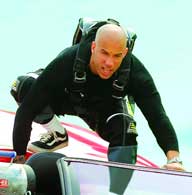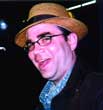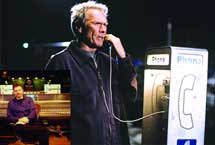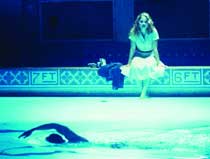
The action-packed XXX was mixed at Warner Bros. on an AMS Neve DFC console. Everything was recorded to a Fairlight.
|
Technology, which was supposed to make our lives easier, has now put audio post professionals into a bit of a pinch. Sure things are a bit easier for all concerned, but now the demands are higher than ever. Once upon a time supervising re-recording mixer Jeffrey Perkins, now of International Recording Corporation, had a whopping 14 weeks to mix the feature Dances With Wolves. His most recent projects have been due in just five to eight weeks. And it's not like the numbers of tracks have diminished, nor the number of effects, the quality of the dialogue or anything else having to do with audio for films.
That said, not many of the folks involved in the film market are complaining. After all, working on the silver screen offers some of the most exciting challenges that are out there these days. From balancing music and effects, dialogue and backgrounds, the collection of post pros interviewed this month by Post are continually excited by their jobs.
There are some obvious connections between these seven professionals, yet each takes a bit of a different track when approaching an upcoming project. Some take care to read scripts before they see a minute of film. Others avoid it as much as possible. Paramount's sound supervisor John Leveque explains, "Sometimes I have to read the script to do the project, because these days they are wanting budgets before they even start shooting. But if I can avoid reading a script, I will do that, because when you're sitting there with the printed page, you are imagining and when you're imagining you are putting words to pictures. That's what the directors do, and my pictures are never anything like the director's pictures. So, it usually throws me in a wrong direction."
These assorted professionals also differ when it comes to sonic approaches and styles of projects. From the high action XXX to the horror film House of 1000 Corpses to the futuristic Equilibrium, sometimes half the fun is finding creative solutions while facing challenges such as tight deadlines, lowered budgets and dirty production audio.
DuArt Film and Video, NEW YORK
 |
Project: Thirteenth Child
Challenge: "The single challenge is how do we clean up particularly wretched audio, because we do get a lot of stuff that's shot on mini DV or on a DVCAM," DuArt's head of audio services, Carmen Borgia explains. "People have cut it on Final Cut and then they decide to do a tape to film, and then the nightmare begins." As an example, Borgia points to Thirteenth Child, which was shot in PAL on Digi Beta. "We wanted to figure out how to destroy the audio the least, knowing that there was going to be a 24-frame film out and that we were going to have to slow down all the sound," he explains. While Borgia points out there are a lot of ways to fix that, this time the team performed a sample rate conversion for all of the raw Pro Tools sessions. "So, we post-conformed in Pro Tools and then we sample rate converted all of the raw audio with Digi Translator," he says. "Then we got NTSC finals of the film out and we cut all of the rest and added the rest of our audio - effects and music - in NTSC. That meant that the dialogue got shifted, but nothing else did. It was a neat trick."

DuArt's Carmen Borgia used Pro Tools and Dolby gear to clean up the audio for the film Thirteenth Child.
|
Tools: Pro Tools was the tool of choice when they performed the shift, and DuArt is wildly dependent on the Waves plug-ins, Borgia says. For cleaning up production dialogue DuArt uses Dolby CAT 43. If they are doing a full-blown mix, they'll move to the large mix room that features an Euphonix CS3000. Thirteenth Child was done in Pro Tools along with Akai's digital dubbers and TASCAM DA-88s.
Tip: "A really good tip is when exporting an OMF out of Pro Tools for some online device, like a Symphony, you have to consolidate the media in Digi Translator to the frame, because if you don't, it goes into the Symphony and the Symphony only sees frames," says Borgia. "If it goes in and it's not quantized and consolidated to the frame, then the Symphony thinks it's the wrong sample rate."
(www.duart.com)
Skywalker Sound
Project: Blood Work
Challenge: While working on Blood Work, a classic police story that has long dialogue scenes, re-recording mixer Christopher Boyes had to enhance the scenes without drawing attention away from the dialogue. "The hardest thing was to keep those alive without them feeling redundant, knowing that there wasn't anything else happening other than dialogue on screen," he says. "We knew going into it that there wasn't going to be a whole lot of music and what music there was, Clint [Eastwood] may decide to leave in or take out. Obviously, the dialogue keeps you engaged, but you want to create this world around it. That was probably the toughest thing from the mixing standpoint.

Skywalker Sound re-recording mixer Christopher Boyes (inset) audio posted Blood Work, a dialogue-heavy police drama starring Clint Eastwood.
|
"The other side of that is it requires a tremendous amount of mixing, both in the pre-mix and the final to keep it from coming too thick, because you have a lot of material and you want to pick the appropriate material rather than all of the material."
Tools: Blood Work was mixed in Skywalker Sound's Mix A, which boasts an AMS Neve DFC console. "In terms of reverb, I still use the Lexicon 480 and I use the TC 6000 quite a bit," he states. The TC 6000 came in handy because Boyes likes to build custom paths when working on an exterior scene and he could build the whole thing within the TC 6000 because it has four engines.
Tip: "Some people say the loud sessions mix themselves in films and I disagree," Boyes reports. "When you get into a loud action-packed scene, pull out everything. Pull out all your backgrounds and pick your biggest, most obvious sound effects that you [need] and pare it down to its complete minimum. Then subtly add back things as you need them, but don't be afraid to be sparse. You lose the audience if you blow them www.skysound.com/ebreak/>(www.skysound.com)
Freelance mixer Joseph Magee
 |
Project: The Country Bears
Challenge: On this particular project, there were a handful of tasks for supervising sound mixer Joseph Magee, including engineering the music sessions for songs that would appeal to children and adults alike; how to get the animatronics bears to lipsync to those songs; and working through the lengthy production process. "The challenge in the beginning was not only pre-recording all the music but we had to pre-record all the dialogue," he explains. To accomplish that, a Pro Tools department was created. "We were responsible not only for playing back music for the music department, we were responsible for playing back all the dialogue that came off the Disney lot out of the ADR studio." Then came legendary music producer Glynn Johns, who worked on the film's original music. "For the first part of the film, I spent a lot of time in the studio with him and he created reference stereo mixes of the music. Then we started on a journey of me taking all the tracks away in Pro Tools and creating playback mixes." Midway into the film Disney opted to add a handful of more contemporary music producers, which added to Magee's responsibilities. "That gave me the challenge of trying to keep all of these tracks from all of these different people together," he says.

Joseph Magee, supervising music mixer on Disney's The Country Bears, was faced with making sure the soundtrack synced with the animatronic bears' lips.
|
Tools: Digidesign's Pro Tools was important on this project to keep everything together and consistent. Magee has used the DAW to perform final mixes along with Pro Control. Magee also used the Millennia Origin STT-1, which is a combination mic pre/EQ/compressor, for just about everything. In Magee's Pro Tools rig, he has the TASCAM MX2424 and the DA-98 HR (which he used on The Country Bears to create pull ups and pull downs), as well as a Panasonic DA7 console that he uses as a router. "I like to have a router in the rig to be able to do complicated things," he explains.
Tip: "There are some people believing that they can do all of their pre-records in pull up, go to the set, pull up and then function in pull down in post, says Magee. There are some music editors that demand that kind of thing, but the traditional technique I settled on a long time ago was to function in 29.97 non-drop as my standard pull down mode based to 599 Hz in a video sync. Whenever I go to the set we pull up to 30 non-drop based on 60 Hz sync and we stay that way, except for when we're back in the music studio again and we go back down. This always assures that in the end, the analog pull up that goes to the set for playback - and makes it through temps - is only used as a reference and never makes it to a final. One of my big pet peeves is people trying to take playback mixes and or reference stereo mixes all the way to final, because editors either don't want to take the time to have to cut back into the picture a new 5.1 mix."
Widget Post Production
Project: House of 1000 Corpses
Challenge: "I think one of the challenges, even though [director] Rob Zombie is quite accomplished as a performer, musician and director of his videos, doing a film was an entirely new process for him and a lot of the conventions we take for granted in sound for filmmaking weren't readily apparent to him," sound supervisor Frederick Howard explains. "So, a lot of the challenge was also guiding him, getting what he wanted to get out of it and make that happen with his help."
Chief engineer Brian Slack adds, "Rob had a very specific idea of what he wanted, but the vocabulary that we take for granted in film production he didn't have, so a lot of times on the stage he kept requesting sound effects with a certain amount of chaos. It was a little different to extract it, but the mixers were able to make him happy. It's a full film and there's a lot of sound design and quite a bit of visceral emotion."
Another challenge the Widget team faced was they did not have film projection capabilities at the facility, so Slack was involved in making sure the project could be transferred to another studio.

A number of audio facilities recently teamed up on the post production for the 20th Century Fox thriller Swimfan. Sound editorial and re-recording took place at the Saul Zaentz Film Center. Louis Febre created the original score. ADR was handled through POP Sound, Sound One and Goldcrest Post Production.
|
Tools: According to Slack, everything at Widget was done in Digidesign Pro Tools, and a lot of the elements were created with Sample Cell. "One of the things we wanted to do was keep it as much in a virtual mix paradigm as possible because we knew we were going to be moving facilities," he explains. "So, as little outboard gear we could use as possible was best so we wouldn't have problems re-creating things at another facility. Not to mention the fact that we knew going into it that there will also be a NC-17 or an unrated version of the film created for a DVD, and we wanted to maintain all the mix aspects so we could easily integrate the current mix into that longer cut."
Tip: "On the human side of this, it's getting to know your clients, finding out what they want and delivering that to them," Howard says. "It's [about] gaining a familiarity with your clients and trying to help them express their art."
(www.widgetpost. com)
Warner Bros.
Project: XXX
Challenge: "It was very challenging [because] it was non-stop from start to finish," says re-recording mixer Dan Leahy. "We wanted to find out from the director our balances that we were going to have so we wouldn't fatigue the audience, because it's a high-energy, high-rolling kind of Fast and the Furious-type of mix for the show." There was also a the question of balancing Randy Edelman's music score with the sound effects, especially in the avalanche scene where they opted to go with no music.
"That particular scene is probably six minutes long," says supervising re-recording mixer Mike Casper. "There was music scored for it and we presented it that way, but it didn't feel right. We finally dropped the music and it kept your breath. When it's over, it goes silent for probably 30 to 40 seconds."
Tools: For this project, Leahy and Casper worked off an AMS Neve DFC console and everything was recorded to a Fairlight. Sound Storm, the company who handled the sound design, used Fairlight as well as Pro Tools and Sonic Solutions gear.
Tip: "You have to believe in what you do," offers Casper. "You cannot try to out-guess somebody else. We do it the way we think it should be done. Believe me, we're not always right and that's a fact, but that's the approach I always take now. You have to believe in what you do." Casper also adds that computers help, but there's something to be said for the old-school way of doing things. "Where there's a feeling to what you're doing as far as mixing."
Leahy concurs, "Follow your true instinct with the film. Be in touch with the film. I usually read the script before hand. If you follow what you think is right it's also much easier to correct for a director."
(http://wbpostproduction.warnerbros.com)
International Recording Corp.
Project: Equilibrium
Challenge: Supervising re-recording mixer Jeffrey Perkins says every film he works on has a unique set a problems to be solved. "Because each film has a different personality based on the people that are involved, I found that the most common challenge is the factor of time and the lack of it. Because of accelerated post schedules, picture editing seems to have less time, and that dominoes into sound."
This film was especially taxing because the sound team was working on two stages at the same time while pick-up photography was still happening.
Tools: Perkins worked on Equilibrium using a Bill Schlegel custom-built Quad 8 console. "That in itself is kind of a challenge because it has only a certain number of faders, and we have to think of creative ways of getting all of the material up onto the board," he says. The Cedar noise reduction tool also came in handy.
Tip: Perkins has worked on films where the director doesn't attend the pre-dub. "We need to keep a great deal of material separate, so the client has options when they get to the stage in the final."
(818-848-5771)
Paramount
 |
Project: Sum of All Fears
Challenge: For this apocalyptic thriller, sound supervisor John Leveque was pressed to make the effects in the film sound real. "There was an atom bomb explosion and it was one of the few times where you were actually in a reality sense involved in that," he says. "A lot of movies take you to that point, but don't have the bomb explosion and others have done it in an apocalyptic way rather than a realistic way. Our challenge in regards to this bomb explosion was to make it as realistic as possible - feeling that you were inside of it." To get that done, Leveque says they avoided any sounds that could be perceived as futuristic. "We used sounds that are everyday sounds or recognizable sounds that gives you a feeling," he says. "My approach to sound is getting the maximum amount of emotion out of the sound, which is generally what the director is trying to do with the actors and everything else. My job is to enhance that or enhance what he's trying to do."
Tools: Leveque does his best to stay away from using any tools or getting mired down in technical talk, however his team uses Digidesign Pro Tools as an editing vehicle, along with a bunch of outboard gear.
Tip: "The audience isn't aware of what tools you used, all they are doing is listening. If you watch the film, that gives you clues to what you need to do. That sounds like an over simplified statement, but a lot of [mixers] don't watch the films. It becomes them creating something of themselves rather than something evolving from what the visuals are in the film." www.paramountstudigroup.com